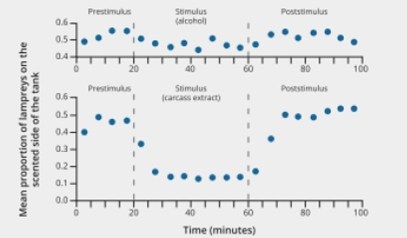
Concept explainers
Deathly Lamprey Repellent Predation by sea lampreys on native fishes in the Great Lakes is an ongoing problem. To help solve it, Michael Wagner and his team test methods of repelling lampreys. They carried out an experiment to investigate reports that sea lampreys detect the scent of lamprey carcasses and tend to avoid them. The researchers made alcohol-based lamprey carcass extracts, then observed what happened when lampreys were put in tanks and exposed to either this extract or to alcohol alone. FIGURE 25.6 shows their results.

FIGURE 25.6 Effectiveness of carcass extracts as a lamprey repellent.
Mean proportion of lampreys on the scented side of the test tank during B trials with 10 lampreys. Lampreys were placed in the tank for 20 minutes before exposure to alcohol or carcass extract and remained there for 40 minutes after exposure. The upper graph shows results with alcohol as the stimulus; the lower shows the results with carcass extracts. Bars indicate standard error.
Why was it necessary to test the response of lampreys to the scent of alcohol alone?
To explain: The reason why it is necessary to test the response of lampreys to the scent of the alcohol alone
Concept introduction: Sea lampreys are chordates that are classified as jawless fishes and are major parasitic carnivorous chordates. The sea lampreys are pests in the Great lakes of the USA as they cause loss of several commercial fishes.
Explanation of Solution
In order to reduce the menace of the lampreys, Scientist M and his team designed an experiment to investigate and report that sea lampreys detect the scent of other lamprey carcasses and have the nature to avoid them. The team used alcohol-based extracts of lamprey carcasses. They then observed the results when lampreys were put in two tanks: one with the alcohol-based extract and another with alcohol alone.
The alcohol serves as a control. The lampreys should not have any reaction towards alcohol as they are the additional substance present along with the tissue extract of lamprey carcass. Therefore, it is necessary to confirm that lampreys are not attracted to the scent alcohol.
The lampreys exposed to alcohol alone in the tank will help us to confirm if the lampreys are attracted to the carcass alone or both alcohol and carcass combined.
Want to see more full solutions like this?
Chapter 25 Solutions
Biology: The Unity and Diversity of Life
Additional Science Textbook Solutions
SEELEY'S ANATOMY+PHYSIOLOGY
General, Organic, and Biological Chemistry - 4th edition
Introductory Chemistry (6th Edition)
Chemistry: Atoms First
Genetics: From Genes to Genomes
- identify the indicated cell in white arrowarrow_forwardGloeocaspa Genus - diagram a colony and label the sheath, cell wall, and cytoplasm. Oscillatoria Genus - Diagram a trichome, and label the shealth and individual cells Nostoc Genus- diagram a sketch of the colonoy microscopically from low power to the left of the drawing. Draw a filament showing intercalary heterocysts, and vegatative cells to the right of the drawing Merismopedia Genus- diagram a sketch of the colony. draw and label a filament showing the colony, cell wall, and sheath. Gloeotrichia Genus- diagram a habit sketch of the colony. draw a filament showing the heterocyst, akimetes and vegatative cells of the filamentarrow_forwardOf this list shown, which genus does the image belong toarrow_forward
- As a medical professional, it is important to be able to discuss how genetic processes such as translation regulation can directly affect patients. Think about some situations that might involve translation regulation. Respond to the following in a minimum of 175 words: Why is translation regulation important? What are some examples of translation regulation in humans? Select one of the examples you provided and explain what happens when translation regulation goes wrong.arrow_forwardThe metabolic pathway below is used for the production of the purine nucleotides adenosine monophosphate (AMP) and guanosine monophosphate (GMP) in eukaryotic cells. Assume each arrow represents a reaction catalyzed by a different enzyme. Using the principles of feedback inhibition, propose a regulatory scheme for this pathway that ensures an adequate supply of both AMP and GMP, and prevents the buildup of Intermediates A through G when supplies of both AMP and GMP are adequate.arrow_forwardQUESTION 27 Label the structures marked A, B, C and explain the role of structure A. W plasma membrane For the toolbar, press ALT+F10 (PC) or ALT+FN+F10 (Mac). BIUS ☐ Paragraph Π " ΩΘΗ Β Open Sans, a... 10pt EEarrow_forward
- examples of synamptomorphyarrow_forwardexamples of synamtomorphy.arrow_forwardE. Bar Graph Use the same technique to upload the completed image. We will use a different type of graph to derive additional information from the CO2 data (Fig A1.6.2) 1. Calculate the average rate of increase in COz concentration per year for the time intervals 1959-1969, 1969- 1979, etc. and write the results in the spaces provided. The value for 1959-1969 is provided for you as an example. 2. Plot the results as a bar graph. The 1959-1969 is plotted for you. 3. Choose the graph that looks the most like yours A) E BAR GRAPH We will use a different type of graph to derive additional information from the CU, data (rig. nive). Average Yearly Rate of Observatory, Hawall interval Rate of increase per year 1959-1969 0.9 1969-1979 1979-1989 1989-1999 1999-2009 Figure A1.6.2 1999-2009 *- mrame -11- -n4 P2 جية 1989-1999 1979-1989 1969-1979 1959-1969 This bar drawn for you as an example 1.0 CO, Average Increase/Year (ppmv) B) E BAR GRAPH We will use a different type of graph to derive…arrow_forward
 Biology: The Unity and Diversity of Life (MindTap...BiologyISBN:9781305073951Author:Cecie Starr, Ralph Taggart, Christine Evers, Lisa StarrPublisher:Cengage Learning
Biology: The Unity and Diversity of Life (MindTap...BiologyISBN:9781305073951Author:Cecie Starr, Ralph Taggart, Christine Evers, Lisa StarrPublisher:Cengage Learning Biology Today and Tomorrow without Physiology (Mi...BiologyISBN:9781305117396Author:Cecie Starr, Christine Evers, Lisa StarrPublisher:Cengage Learning
Biology Today and Tomorrow without Physiology (Mi...BiologyISBN:9781305117396Author:Cecie Starr, Christine Evers, Lisa StarrPublisher:Cengage Learning





